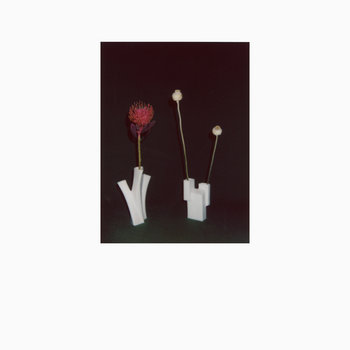
French poet and ASMR auteur Félicia Atkinson has frequently fixated on the elusive interwoven relationship between microcosms and macrocosms – how even the quietest creative act ripples outward in unforeseen ways, a whisper with no fixed meaning. Her latest work pursues this notion in a more literal and lasting fashion, as it was crafted while pregnant on tour, in impersonal hotel rooms in foreign cities. She describes it as "a record not about being pregnant but a record made with pregnancy." Each day and night, finding herself far from home, she asked herself "What am I doing here? How can I connect myself to the world?" The answer gradually revealed itself: "With small gestures: recording my voice, recording birds, a simple melody."
In truth there is nothing simple about The Flower & The Vessel. The album's 11 songs span a vast pantheon of whispering textures, opaque moods, and surreal spoken word, leading the listener through a mirrored hall of beguiling mirages. Atkinson cites a trio of French classical compositions from her childhood as formative influences on this particular collection: Maurice Ravel’s "L'enfant et les sortilèges" ("a scary opera for kids"), Debussy’s "La Mer" (for its union of narration and music) and Erik Satie’s "Gymnopédies" (as an exercise in negative space, irony without cynicism, and "melody with doubt"). There's certainly a shade of classicism woven within these tracks, however veiled, abstracted, or unorthodox. Melancholic piano motifs repeat then retreat into a radiant frost of shivering frequencies; processed voices recite cut-up poems and interviews over delay-refracted Rhodes and Wurlitzer; iPad gamelan patterns flutter from meditative to melancholic and back again, offset by pointillist patches of delicate software synesthesia.
Although much of Atkinson’s past discography is shaped by speech and the lyricism of language, The Flower & The Vessel ventures farther into silence, absence, and voiceless wilderness. Among her sources of inspiration were "women who wonder, dream, and create vacant spaces in their art," as well as Ikebana flower arrangements, which reflect her own relationship with listening: "structure combined with everyday noises, selecting them to make a sparse music bouquet." Field recordings from Tasmania and the Mojave Desert murmur beneath hushed reverberations of gong, vibraphone, marimba, softly processed into an elegant emptiness, alternately eerie and serene.
Her mode of minimalism has long been one of reduction, riddles, and curation, but here Atkinson's synergy feels close to apotheosis, emotive but ambivalent, a ceremony of expectation and invisible forces. The 19-minute closing collaboration with SUNN O))) guitarist Stephen O’Malley, "Des Pierres," is one of the album’s few pieces tracked in a proper studio (Music Unit in Montreuil, France) but it broods and burns with the same subliminal majesty as the rest of The Flower & The Vessel: an ember in amber, seeds planted in shifting sands. Atkinson’s voice flickers like a flame, framed by slabs of shadowy feedback. Her process may be personal is but its impact ripples to the edges of existence: "How does the act of creation connect us, not only to history, but to the cosmic? It’s a process of taking, and then giving back. It makes us belong to the world."
More information can be found here.
Read More

